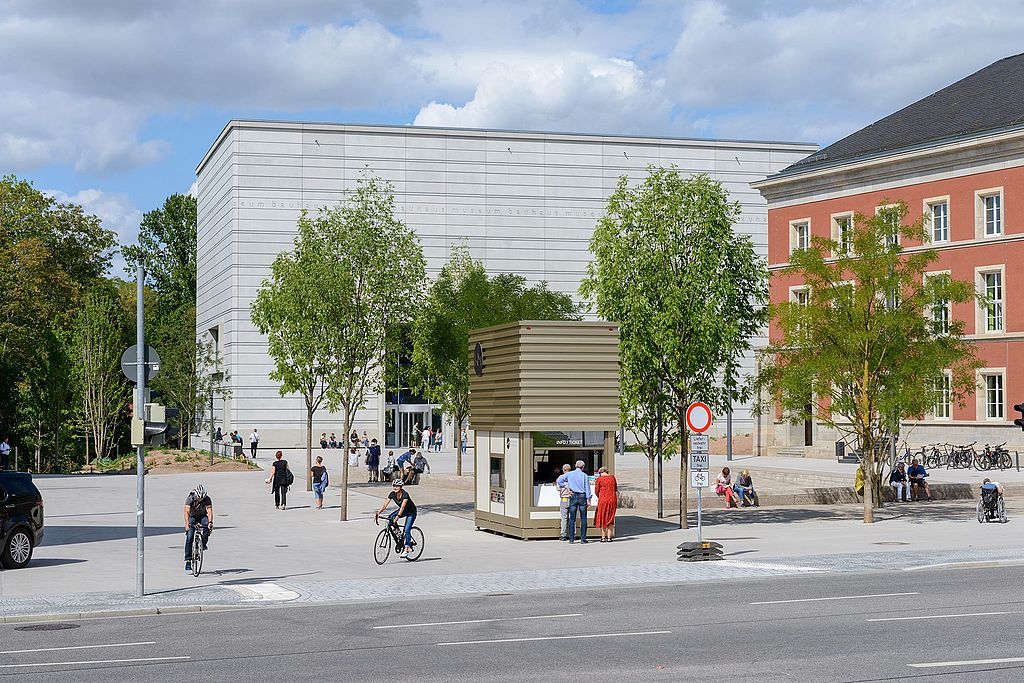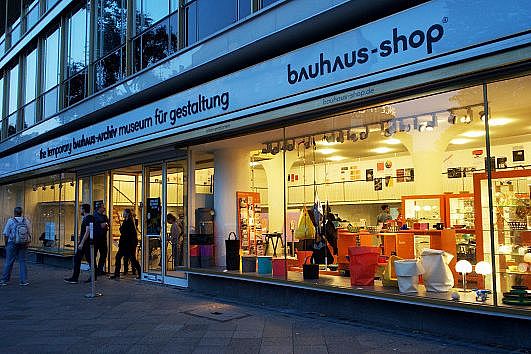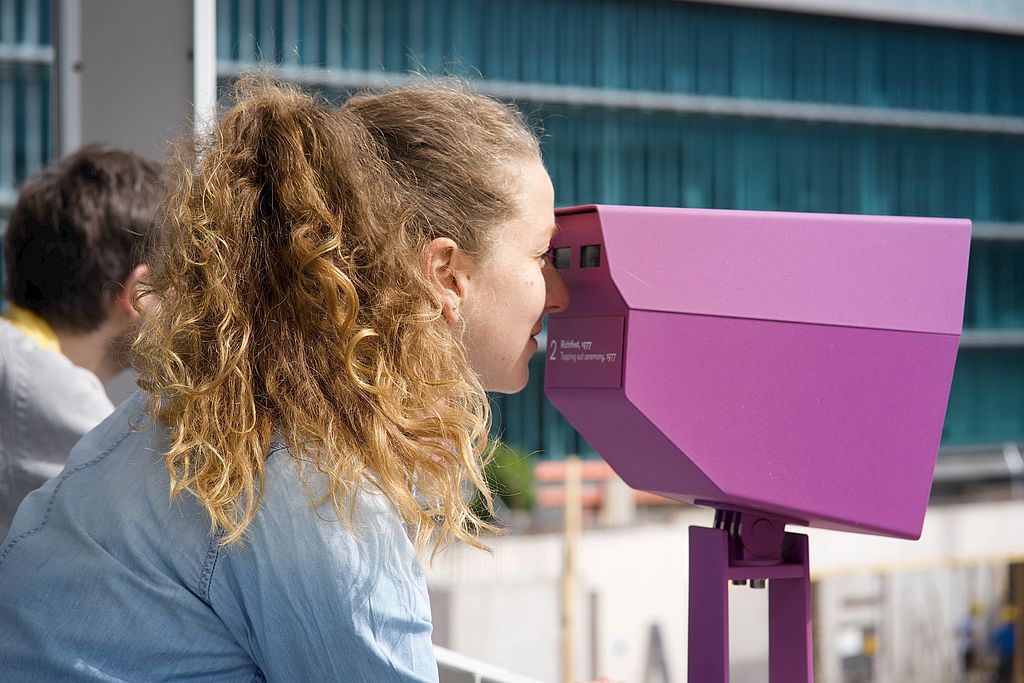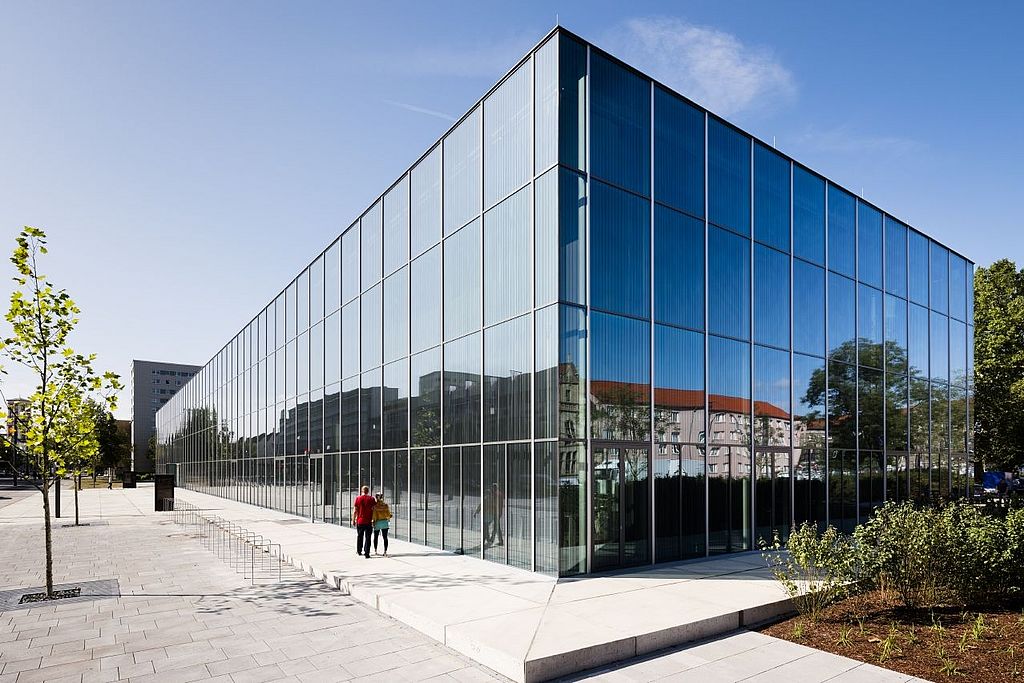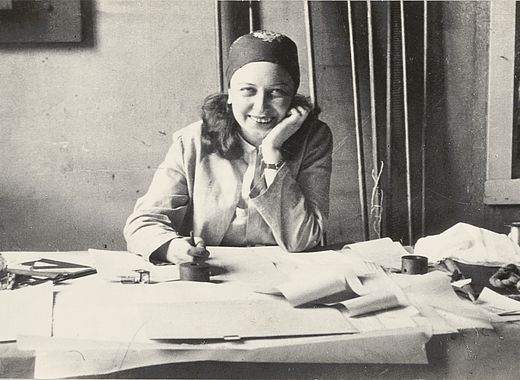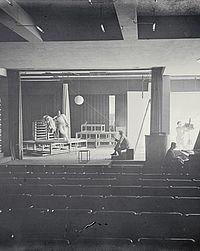Current exhibitions of the 3 bauhaus venues
Place of modernity
Le Corbusier House at Weissenhof Estate
Stuttgart
The Weissenhof Estate, with two houses by Le Corbusier that are on the UNESCO World Heritage List, is one of the world’s most important architectural monuments of classic modernism. Prominent international representatives of the New Architecture movement created the housing estate in 1927.
Masters’ Houses
Dessau-Roßlau
With the Masters’ Houses (1925–26), Walter Gropius implemented his ideas of the New Architecture for the first time in a group of homes. The three pairs of semi-detached houses and the director’s house are regarded around the world as prototypes of modern architecture and rank among the UNESCO World Heritage Sites.
Glassworks
Amberg
The Glassworks in Amberg was Walter Gropius’s last work. Together with his firm TAC, he designed the spectacular industrial building for factory owner Philip Rosenthal. The “Glass Cathedral”, a listed historical monument, was completed in 1970, one year after Gropius’s death.
Bauhaus Museum Dessau
Dessau-Roßlau
The Bauhaus Museum Dessau was opened on September 8, 2019 to mark the 100th anniversary of the founding of the Bauhaus. For the first time, the new museum has suitable premises for a comprehensive public presentation of the valuable collection of the Bauhaus Dessau Foundation.
Rammelsberg
Goslar
The Rammelsberg near Goslar is home to a unique ensemble of architectural monuments to German mining history. The above-ground structures of the UNESCO World Heritage Site impressively show the development of modern industrial structures during the era of National Socialism.
Kaiser Wilhelm Memorial Church
Berlin
The Kaiser Wilhelm Memorial Church (1961) is a monument for peace with powerful historic symbolism. Egon Eiermann integrated the tower ruins of the church, which had been mostly destroyed in the Second World War, into a new complex of four free-standing buildings of reinforced concrete.
Lange House | Esters House
Krefeld
In the Lange and Esters Houses (1930), Ludwig Mies van der Rohe combined the New Architecture with the rather conventional spatial programme of a home for the upper middle class. The unadorned, box-like brick buildings are among the highlights of the Bauhaus city of Krefeld.
Lehmbruck Museum
Duisburg
The Lehmbruck Museum in Duisburg (1964/1987) presents the oeuvre of the prominent sculptor Wilhelm Lehmbruck (1881–1919). His son Manfred Lehmbruck designed an impressive ensemble of post-war modernism that captivates with its expressive variety.
Hohenhof
Hagen
Henry van de Velde designed the Hohenhof villa (1906–1908) in Hagen for the founder of the Folkwang idea, Karl Ernst Osthaus. The Gesamtkunstwerk of Art Nouveau is today a museum for the “Hagen Impulse” and honours its cultural and historical significance.
Schulenburg House
Gera
The Schulenburg Mansion in Gera embodies nascent modernism in Europe. Built between 1913 and 1915, it was designed by Belgian architect Henry van de Velde as a Gesamtkunstwerk, a total work of art. Today the villa houses a museum that presents Van de Velde’s work in an unparalleled fashion.
Museum Angewandte Kunst
Frankfurt am Main
The Museum Angewandte Kunst (Museum of Applied Arts) in Frankfurt am Main is a recognised icon of postmodernism. The ensemble created by Richard Meier (1987) consists of a neo-classicist villa embraced by a new building. The complex skilfully plays with the stylistic elements of functionalism.
Steel House
Dessau-Roßlau
With the Steel House, built in 1927 on the edge of Gropius’s Dessau-Törten Estate, Richard Paulick and Georg Muche tested the applicability of steel for residential construction. It is an important testimony to the innovative ideas that shaped the Bauhaus in the 1920s.
Leipzig Trade Fair
Leipzig
The Leipzig Trade Fair is one of the most modern exhibition and congress centres in the world. The vaulted Glass Hall is its impressive centrepiece. This masterpiece of architectural and engineering skill is Europe’s largest fully glazed structure.
Deutsches Architekturmuseum
Frankfurt am Main
The Deutsches Architekturmuseum (DAM), or German Architecture Museum, opened in 1984 in a Wilhelminian-style villa converted by the architect Oswald Mathias Ungers. The centrepiece of his white museum architecture is a cubic structure – the “house-in-house” as a metaphor for architecture.
Völklingen Ironworks
Völklingen
The Völklinger Hütte was the first industrial monument to be declared a UNESCO World Heritage Site in 1994. The imposing buildings of the former iron production plant, which is now used as a cultural site, are considered pioneers of modern industrial architecture.
Altstädter School
Celle
The Altstädter School (1928) is an outstanding example of classical modernism. It is one of the best-known works of the architect Otto Haesler – who, as a pioneer of the New Architecture during the 1920s, played a decisive role in shaping the cityscape of Celle.
Siemensstadt Housing Estate
Berlin
Siemensstadt is a large housing estate and UNESCO World Heritage Site designed as a joint project by architects including Walter Gropius and Hans Scharoun. It displays the entire range of the New Architecture style and served as a model for housing built after the Second World War.
Taut’s Home
Berlin
Taut’s Home, which first opened its doors to holiday guests in 2012, exemplifies the architecture of Berlin Modernism in an experienceable way. The faithfully reconstructed house offers a unique opportunity to directly experience the architecture of Taut’s Horseshoe Estate in Berlin (1925–30), which is a UNESCO World Heritage Site.
Becker Tower
St. Ingbert
The Becker Tower was built between 1925 and 1931 for the Becker brewery of the St. Ingbert in Saarland. Hans Herkommer created the industrial building, now a listed monument, in the style of the New Architecture. Today, its tenants include a museum and a restaurant.
Magdeburg Civic Hall
Magdeburg
The ensemble of civic hall, entry gateway and observation tower is an important example of the New Architecture. Built for the 1927 German Theatre Exhibition, the buildings rank among the main works of the architects Johannes Göderitz and Albin Müller.
Loheland
Künzell-Loheland
The women's settlement in Loheland was an important center of the European reform movement in the 1920s. To this day, the holistic teaching practiced there and the existing monuments have an outstanding cultural-historical value.
Carl Legien Housing Estate
Berlin
With the Carl Legien Housing Estate, Bruno Taut demonstrated that socially equitable residential development is possible despite high urban density. The UNESCO World Heritage Site is one of the outstanding examples of the new housing projects of the Weimar Republic.
Steinberg, Herrmann & Co. Hat Factory
Luckenwalde
The former Steinberg, Herrmann & Co. Hat Factory (1923) by Erich Mendelsohn is one of the pioneering works of the New Architecture movement. Thanks to its hat-like roof structure, the expressionist industrial building became a symbol of Luckenwalde.
Fagus Factory
Alfeld an der Leine
Built in 1911, the Fagus Factory in Alfeld ranks internationally as one of the masterpieces of modern architecture. The factory building is an early work by Bauhaus founder Walter Gropius. The UNESCO World Heritage Site, with its striking glass façade, is still actively used today for manufacturing.
Diesel Power Plant
Cottbus
The diesel power plant in Cottbus, designed and built in 1927 by Werner Issel, is an impressive monument to modern industrial architecture. Since 2008, the architectural heritage of the expressionist brick ensemble has been kept alive as an art museum.
Horseshoe Housing Estate
Berlin
Bruno Taut’s Horseshoe Housing Estate in Britz is recognised internationally as a key work of modern urban housing construction. The UNESCO World Heritage Site was trailblazing for the architecture of its time and paved the way for a new form of social housing.
Deaconess Motherhouse "Neuvandsburg"
Oberharz am Brocken/Elbingerode
The Deaconess Motherhouse in Elbingerode, nearly unchanged since it was built, offers a chance to experience many details of the New Architecture. Architect Godehard Schwethelm created this ultra-modern complex between 1932 and 1934. 150 Protestant nuns still live there today.
Dessau Employment Office
Dessau-Roßlau
The Dessau Employment Office (1929) by Walter Gropius is a pioneering example of functionalist architecture. The layout of the distinctive semicircular building and the adjoining administrative block is rigorously derived from organisational procedures in the office.
Garden City Colony „Reform“
Magdeburg
The colourful „Reform“ Housing Estate in Magdeburg is an early example of Germany’s garden city movement. Its design is largely based on plans by Bruno Taut. Carl Krayl and Franz Hoffmann, among others, were also involved in building the estate between 1913 and 1938.
Museum Neues Weimar
Weimar
The Neo-Renaissance building was erected in 1869 as one of the first German museum buildings and can look back on an eventful history. The Neues Museum Weimar opened in April 2019 with a permanent presentation of early modern art.
Houses with Balcony Access
Dessau-Roßlau
The Houses with Balcony Access in Dessau-Törten embody the beliefs of Hannes Meyer, the second Bauhaus director, whose credo was simple: “Put the needs of the people before the needs of luxury”. Together with his students, he designed the five apartment blocks in 1929/30. They have been inscribed on the UNESCO World Heritage List since 2017.
Reichstag Building
Berlin
With his transformation of the Reichstag (1999), Norman Foster created a symbol of German unity. Originally designed by Paul Wallot, the building had been erected at the end of the 19th century. The signature glass-and-steel dome has become one of Berlin’s landmarks.
Falkenberg Garden City
Berlin
The garden city estate of Falkenberg was among the earliest examples of a new type of social housing in Berlin. This UNESCO World Heritage Site is an early work by Bruno Taut. It is here where he used his hallmark colour concepts as a design tool for the first time.
Garden City Hellerau
Dresden
Hellerau was Germany’s first garden city, created from 1909 onwards on the initiative of Werkbund co-founder Karl Schmidt. Here, he realised his idea of a social-reformist housing estate that unites living with work, culture and education.
Haus des Volkes
Probstzella
Known today as the Bauhaus Hotel, the Haus des Volkes in Probstzella (1927) invites you to explore, visit the café or spend the night. Many of its furnishings are replicas of the original furniture by Bauhaus members such as Alfred Arndt, Marcel Breuer and Marianne Brandt.
German Environment Agency
Dessau-Roßlau
The German Environment Agency in Dessau-Roßlau was built in 2005 as a federal model project, to plans by Sauerbruch Hutton. The architects responded in their design to issues of climate change and rigorously addressed the use of renewable energies.
Dessau-Törten Housing Estate
Dessau-Roßlau
With the first construction phase of the Dessau-Törten Housing Estate (1926–28), Walter Gropius put new low-cost production and construction methods to the test. As an experimental housing estate, it is an exemplary model for the serial production of social housing.
Einstein Tower
Potsdam
Between 1919 and 1922 the Einstein Tower was built in Potsdam – a solar observatory to prove the theories formulated by Albert Einstein. Erich Mendelsohn designed the expressionist building, which is considered an icon of the architectural awakening.
Ulm School of Design
Ulm
The Ulm School of Design (1955–1968) was founded as a successor to the Bauhaus, and its architecture also embodies the Bauhaus philosophy. The educational complex designed by Max Bill captivates with its sober, reduced architectural language.
Arnstadt Dairy
Arnstadt
The Arnstadt dairy processing plant designed by Martin Schwarz in 1928 illustrates how modernist industrial buildings combined functionality and social responsibility into an architectural unity. The historical monument is currently under renovation for use as a cultural centre.
Ernst May House
Frankfurt am Main
The Ernst May House is an example of the New Frankfurt housing construction programme carried out under city planning commissioner Ernst May. Between 1925 and 1930, 12,000 affordable dwellings were built with modern conveniences that included the innovative Frankfurt kitchen designed by Margarete Schütte-Lihotzky.
Technische Hochschule Ulm
Ulm
Günter Behnisch, who is known as the “master builder of democracy”, designed the Ulm University of Applied Sciences campus, which was completed in 1962. The functionalist ensemble is a key work of post-war modernism for more than just its then-groundbreaking prefabricated construction method.
Federal Chancellery
Berlin
The German Federal Chancellery in Berlin (1997–2001) by Axel Schultes and Charlotte Frank is part of the “Federal Ribbon” building ensemble. As one of the most important new government buildings in the German capital, it epitomises government architecture that conveys openness and transparency.
Chilehaus
Hamburg
Chilehaus was one of the first high-rise buildings in Hamburg and is an icon of German Brick Expressionism. This UNESCO World Heritage property still impresses with its unusual building shape and richly detailed clinker brick façades.
Zollverein Coal Mine Industrial Complex
Essen
With construction of the centrally located Shaft XII (1928–1932), Fritz Schupp and Martin Kremmer created one of the most important surviving examples of modern industrial architecture. Today, the UNESCO World Heritage Site is a popular cultural tourism attraction and a symbol of the transformation of the city of Essen and the Ruhr area.
Hamburg’s Ohlsdorf Crematorium
Hamburg
With his New Crematorium (1930–32), Fritz Schumacher – architect, founding member of the Werkbund and Hamburg’s long-serving building director – created a typical work of Northern German Brick Expressionism. The symmetrical complex was his last building in Hamburg.
Bauhaus Museum Weimar
Weimar
On the occasion of the 100th anniversary of the State Bauhaus founded in Weimar in 1919, the Bauhaus Museum Weimar opened in 2019. Since then, the treasures of the world's oldest Bauhaus collection have been presented in Heike Hanada's minimalist cube.
Liederhalle Stuttgart
Stuttgart
The Stuttgart Liederhalle was built in 1956 based on designs by Rolf Gutbrod and Adolf Abel. The playful ensemble is one of the most important cultural buildings of the post-war period. In 1991 it was expanded by Wolfgang Henning into a culture and congress center.
Konrad Wachsmann House
Niesky
Konrad Wachsmann was a pioneer of industrialised construction. He developed a prefabricated system for timber construction that he used in exemplary fashion in Niesky. The Wachsmann House (1927) stands out due to its modern, Bauhaus-inspired formal language.
Deutsches Hygiene-Museum Dresden
Dresden
The imposing home of the Deutsches Hygiene-Museum in Dresden (1927–1930) features various stylistic elements. As designed by Wilhelm Kreis, the architecture combines monumental elements of classicism with the style of the Neue Sachlichkeit, or New Objectivity.
VerSeidAG Dyeworks and Warehouse
Krefeld
The VerSeidAG building in Krefeld (1931), a straightforward and unadorned rectangular block, still epitomises functional, modern industrial architecture. It is the only factory building designed by Ludwig Mies van der Rohe that was built anywhere in the world and is now a listed historic monument.
Garden City Piesteritz
Wittenberg
The Piesteritz Workers’ Housing Estate (1916–19) is a paragon example of the garden city movement and reform architecture. Georg Haberland, Otto Rudolf Salvisberg and Paul Schmitthenner created the residential development for the employees of the Central German Nitrogen Works.
Konsum Building
Dessau-Roßlau
The Konsum Building (1928), designed by Walter Gropius, forms the centre of the well-known experimental Dessau-Törten Estate due to its location and prominent tower block. The simple, functionalist building and the entire estate constitute an important monument to modernism.
White City Berlin
Berlin
The White City, a UNESCO World Heritage Site, is one of Berlin’s most outstanding modernist housing estates. In the early 1930s, it particularly stood out for its high social standard and was the epitome of modern, affordable living.
Böttcherstraße
Bremen
Bremen’s Böttcherstraße is an eclectic total work of art that combines elements of Brick Gothic, Expressionism and Art Deco. It was created between 1922 and 1931 and is considered an important example of architecture from the interwar years.
Kornhaus
Dessau-Roßlau
The Kornhaus restaurant was built in 1929–30 by Carl Fieger during his time at the Bauhaus. With its striking semicircular prow, the building is typical of the architectural style of Fieger, whose works have made an important contribution to modern architecture.
Bauhaus-Archive / Museum of Design
Berlin
The Bauhaus-Archiv / Museum für Gestaltung (1979) holds the world’s largest Bauhaus collection. The building, whose distinctive sawtooth roof silhouette has made it one of Berlin’s landmarks, is based on a design by Walter Gropius. The building is currently being renovated and supplemented by a new building by Staab Architekten. Visitors are received in the temporary bauhaus-archiv.
Bauhaus Building
Dessau-Roßlau
The school building (1925/26) by Walter Gropius is regarded internationally as an icon of modern architecture. The Bauhaus experienced its heyday in the functional, minimalist building complex. Today it is part of a UNESCO World Heritage Site and home to the Bauhaus Dessau Foundation.
Kreutzenberger Winery
Kindenheim
The Kreutzenberger Winery in Kindenheim, Rhineland-Palatinate, is a unique example of how the New Architecture influenced the design of wineries. Designed by Otto Prott in 1929, the cube-like building received an award-winning expansion in 2004–2007.
GRASSI Museum
Leipzig
The Grassi Museum (1925–1929) in Leipzig is a total work of art of the modernist era. New Objectivity, Art Deco and the Bauhaus converge in a unique way in this building. Especially impressive are the glass windows by Bauhaus Master Josef Albers.
German Film Institute and Museum
Frankfurt am Main
The German Film Museum (DFF), opened in 1984, is housed in a Wilhelminian-style villa that has undergone repeated radical reconfigurations. Helge Bofinger initially implemented a postmodern house-in-a-house concept in 1984, and the building was again thoroughly remodelled by the firm Blocher Partners in 2009–11.
Eiermann Building Apolda
Apolda
The Eiermann Building in Apolda (1938/39) is an icon of industrial architecture and an outstanding example of sustainable building conversion. The expansion in the style of the New Architecture laid the groundwork for the career of architect Egon Eiermann.
Car Park South
Halle (Saale)
Walter Tutenberg’s Car Park South, one of Germany’s oldest multi-storey parking structures, is an outstanding example of the New Architecture. This functional building with its ultra-modern lift system was far ahead of the architecture of its day.
Blumläger Feld Housing Estate
Celle
The Blumläger Feld Housing Estate (1930/31) was the most radical and controversial project by Otto Haesler in Celle. With standardised floor plans and rational design, he created particularly low-priced dwellings of minimal size – social housing in its most rigorous form.
Rosenthal Porcelain Factory
Selb
The Rosenthal Porcelain Factory in Selb is an important late work by Walter Gropius and bears witness to the influence of the Bauhaus in Bavaria. Gropius created the innovative industrial building in close collaboration with the client, Philip Rosenthal.
Haus Am Horn
Weimar
The Haus Am Horn was built in 1923 as a model house for the first Bauhaus exhibition in Weimar. It is the first example of Bauhaus architecture built in Weimar and ranks as a prototype of modern construction and living. Today, the UNESCO World Heritage Site is an exhibition venue.
Hermann Beims Estate
Magdeburg
The Hermann Beims Estate in Magdeburg (1925–29) is considered an exemplary social housing development. Based on plans by Bruno Taut, inexpensive and thoughtfully designed flats were built in the style of the New Architecture. Today, the housing estate is a protected heritage area.
Hellerau Festival Theatre
Dresden
The Festival Theatre, built in 1911/12 by Heinrich Tessenow in the garden city Hellerau, was a radical alternative to traditional theatre buildings. Mary Wigman once danced here. Today, Hellerau is still a centre of contemporary art.
Schminke House
Löbau
The Schminke House (1930–1933) is one of the key works by the architect Hans Scharoun. The home in the Saxon town of Löbau is regarded worldwide as a prime example of the “Neues Bauen”, and of modern architecture in the International Style.
Schocken Department Store
Chemnitz
With his design for the Schocken department store (1930), Erich Mendelsohn realised the ideals of the International Style. The building combines function with dynamism and stands as a milestone of the New Architecture. Today it houses the State Museum of Archaeology.
Schillerpark Housing Estate
Berlin
Die Berliner Siedlung Schillerpark von Bruno Taut gilt als erstes großstädtisches Wohnprojekt der Weimarer Republik. Bis heute zählt die UNESCO-Welterbestätte zu den wichtigen Beispielen des sozialen Wohnungsbaus nach dem Ersten Weltkrieg.
Giebichenstein Bridge
Halle (Saale)
The Giebichenstein Bridge in Halle was built between 1926 and 1928 with contributions by Werkbund members Paul Thiersch and Gerhard Marcks. The bridge is adorned with two large animal sculptures and stretches out along the foot of the Giebichenstein Castle in Halle.
Ehem. Großherzogl. Kunsthochschule & Kunstgewerbeschule
Weimar
Van de Veldes ehemalige Kunstschule mit Bauhaus-Atelier (1904-11) und die ehemalige Kunstgewerbeschule (1905-06) wurden 1919 zum Staatlichen Bauhaus Weimar vereint. Heute beherbergen sie die Bauhaus Universität Weimar und zählen zum UNESCO-Welterbe.
House of Youth
Hamburg
In the middle of downtown Altona, the House of Youth bears witness not only to the New Architecture movement, but also to the educational reforms of the Weimar Republic. It was built according to the designs of Gustav Oelsner as a vocational training centre in 1928–1930.
Kunsthalle Darmstadt
Darmstadt
The Kunsthalle, built in 1957 by Theo Pabst, was one of the first museum buildings to be built after the Second World War. The simple, open building in the style of classic modernism dispenses with monumental gestures and represents the new beginning undertaken after 1945.
ADGB Trade Union School Bernau
Bernau bei Berlin
The ADGB Trade Union School in Bernau is one of the largest Bauhaus ensembles in the world. Today’s UNESCO World Heritage Site was built in 1928–30 under the direction of the second Bauhaus director, Hannes Meyer, with the aid of students from the Dessau Bauhaus.
Head of modernity
Hubert Hoffmann
1926–1929 Bauhaus student
After 1945 it was Hoffmann who led efforts to secure the war-ravaged Bauhaus buildings in Dessau. Mayor Hesse tasked him with reviving the Bauhaus – but the plan ultimately failed.
László Moholy-Nagy
1923–1928 Bauhaus master
László Moholy-Nagy was the genius of all media. He was a living example of his own educational philosophy as a self-taught artist – at the Bauhaus and later at the New Bauhaus in Chicago.
Heinz Schwerin
1931–1932 Bauhaus student
Schwerin and his wife were among 25 Bauhäusler who emigrated to Palestine. The Schwerins were not Zionists: they simply lacked alternatives.
Horacio Coppola
1932 Bauhaus student
When Horacio Coppola and Grete Stern showed their Bauhaus photographs in Buenos Aires they injected significant momentum into the development of modern Argentinian photography.
Walter Gropius
1919–1928 Director of the Bauhaus
Walter Gropius founded the Bauhaus in 1919 as a new type of art school that combined life, craft and art under one roof. Gropius managed the Bauhaus as its director until 1928.
Josef Albers
1920–1923 student at the Bauhaus / 1923–1933 Bauhaus young master
Gropius appointed Josef Albers as a young master before he had even qualified as a journeyman. He was in charge of the preliminary course, where he formulated a pioneering approach to art education.
Heinrich Clasing
1930–1933 Bauhaus student
Clasing had experienced first-hand what it was like to scratch a living due to the Bauhaus stigma, so he devoted himself to showing banned avant-garde artists at his own little gallery in Münster.
Eberhard Schrammen
1919–1925 Bauhaus student
Schrammen’s ‘Bauhaus Mascot’ integrates typical elements of Bauhaus design: a cylinder, a sphere and a hemisphere as basic shapes and the primary colours blue, red and yellow.
Werner Graeff
1921–1922 Bauhaus student
Werner Graeff caused quite a splash in 1928 with his book ‘Es Kommt Der Neue Fotograf!’ (Here comes the new photographer). At the time, the featured forced perspectives, detailed views and unretouched, close-up portraits were revolutionary.
Adolf Meyer
1920–1925 Bauhaus teacher
He was Walter Gropius’s right-hand man, his number 1 planner and a close confidant. In 1910 they had already worked together on the Fagus Factory, one of the most significant buildings in modernist architecture.
Margaretha Reichardt
1926–1931 Bauhaus student
Reichardt made a particularly resilient and durable polished thread called ‘iron yarn’ that was used to span Marcel Breuer’s tubular steel furniture.
Arieh Sharon
1926–1929 Bauhaus student
He was the man at the side of Bauhaus master Gunta Stölzl: Arieh Sharon. He was later among the European architects who defined the “White City” of Tel Aviv.
Alfredo Bortoluzzi
1927–1928 Bauhaus student / 1930 guest student
Alfredo Bortoluzzi was an enthusiastic member of the Bauhaus theatre company under Schlemmer. After graduating from the Bauhaus he became a professional dancer, choreographer and set designer.
Gertrud Grunow
1919–1924 Teacher at Bauhaus Weimar
The musician had formulated her own approach to teaching music, seeking to address all the senses in a harmony of equals. Her classes were attended by masters as well as students.
Judit Kárász
1930–1932 Bauhaus student
Judit Kárász was one of the few students to explore social photography. With her camera she ventured a glimpse behind the scenes of bourgeois life and documented poverty and social exclusion.
Maria Rasch
1919–1923 Bauhaus student
After training there, she put the Bauhaus in touch with her family’s company, Gebrüder Rasch in Bramsche, who still market the Bauhaus wallpaper designs.
Friedrich Engemann
1927–1929 Bauhaus student / 1929–1933 Bauhaus teacher
With his experience as an architect and vocational trainer, Engemann was taken on to teach architectural drawing, fitting out and descriptive geometry at the Bauhaus.
Isaak Butkow
1928–1932 Bauhaus student
Butkow was the linchpin of a Communist cell at the Bauhaus. In 1932 he was expelled. He went to the Soviet Union as political émigré, but in 1937 he was accused of espionage and sentenced to death.
Ludwig Hilberseimer
1929–1932 Bauhaus teacher
Abstract, open, useful. Those were the modern principles that Hilberseimer instilled in his students of architecture and of housing and urban design. He recorded his urban planning theory in numerous publications.
Otto Umbehr
1921–1923 Bauhaus student
Umbo ranks among the leading photographers of the Bauhaus and modernist style, but he only discovered photography as his artistic medium after studying at the Bauhaus.
Marianne Brandt
1923–1929 student / 1928–1929 Deputy Head of Metal
László Moholy-Nagy quickly recognised her unique talent. With his encouragement, Brandt studied in the male domain of the metal workshop – proving more successful than many of her classmates.
Grit Kallin-Fischer
1926–1928 Bauhaus student
Kallin was one of the few women alongside Marianne Brandt in the Bauhaus metal workshop, but it was above all in photography that she displayed great talent.
Hans Wittwer
1927–1929 Bauhaus teacher
Wittwer was Hannes Meyer’s right-hand man and his partner in the practice. When Meyer was appointed director of the Bauhaus, Wittwer accompanied him to Dessau to teach.
Lyonel Feininger
1919–1932 Bauhaus master
Feininger was one of the first masters recruited to the Bauhaus by Gropius in 1919. His woodcut ‘Cathedral’ adorned the cover of the Bauhaus Manifesto.
Marcel Breuer
1920–1924 Bauhaus student / 1925–1928 Bauhaus young master
He was the first furniture designer ever to use tubular steel. Breuer quickly grasped how to use this material, combining it with textiles for optimum comfort.
Max Nehrling
1919–1921 Bauhaus student
In 1920 Nehrling made a simple ‘Chinese hat’ from cardboard for a Bauhaus party. He kept this hat all his life. Today it offers historical evidence of life at the Bauhaus.
Lilly Reich
1932–1933 Master at Bauhaus Dessau and Berlin
She was the woman at Mies’s side. In 1932 Lilly Reich took over the fitting out workshop and officially became the second female Bauhaus master.
Ludwig Mies van der Rohe
1930–1933 Director of the Bauhaus
Ludwig Mies van der Rohe was a shining star of German avant-garde architecture when he joined the Bauhaus as its director. This post enabled the architect to devote his energy to teaching for the first time.
Gerhard Marcks
1919–1924 Bauhaus master
Sculpture, pottery and woodcuts were life’s blood to Marcks. As master of form he set up the pottery workshop at the Bauhaus.
Carl Marx
1932–1933 Bauhaus student
Marx took a long time after studying at the Bauhaus to find his own way as an artist. Influenced by various modernist styles, his paintings reflected a world detached from reality.
Chanan Frenkel
1930–1932 Bauhaus student
Frenkel was a co-founder of Germany’s first kibbutz and in 1928 he emigrated to Palestine. In 1930 be took up his studies at the Bauhaus, later returning to play in active part in Palestine’s development.
Herbert von Arend
1928–1932 Bauhaus student
He was one of the few men in the Bauhaus weaving workshop. In 1931 he took part in the revolt against Gunta Stölzl, then left the Bauhaus and became a tax inspector.
Alma Siedhoff-Buscher
1922–1927 Student at Bauhaus Weimar and Dessau
Alma Buscher designed toys that allowed children to imitate but also to unfold their own creativity. Her ‘Little Ship-Building Game’ is still produced today.
Alfred Arndt
1929–1932 Bauhaus master
He came across the Bauhaus in Weimar more or less by chance – and after his first conversation with Walter Gropius he knew he would be staying. Years later Arndt took over the Building and Fitting Out department.
Wassily Kandinsky
1922–1933 Bauhaus master / 1923–1933 Deputy Director
When Kandinsky was appointed by the Bauhaus, he was already one of the great names in modern art. For young people with talent, this was often reason enough to attempt the Bauhaus experiment.
Josef Hartwig
1921–1925 Bauhaus master
When Hartwig designed his famous Bauhaus chess set, it met all the criteria defined for an object by Gropius: practical, durable, inexpensive and beautiful.
Ivana Tomljenović
1929–1930 Bauhaus student
“Good luck, Bauhaus and Berlin comrades, see you after the revolution”: Tomljenović processed her expulsion from the Bauhaus in a photocollage.
Otti Berger
1927–1930 Student / 1931–1932 deputy head of Weaving at Bauhaus Dessau
Berger was acting head of Weaving after Gunta Stölzl left. She later opened her own Textile Studio but being Jewish she was soon banned from practising her trade. Otti Berger died in Auschwitz in 1944.
Corona Krause
1924–1925 Bauhaus student
Corona Krause had just turned 18 when she came to the Bauhaus in Weimar. Here she studied in the weaving workshop, later becoming a textile and fashion designer.
Georg Muche
1920–1927 Bauhaus master
Muche was one of the youngest Bauhaus masters. The Haus am Horn, based on his designs, was in fact the ‘dream house’ he had designed for himself and his young wife El.
Wilhelm Löber
1923–1925 Bauhaus student
Wilhelm Löber trained in several art forms and over the next centuries never stopped experimenting. Time and again he tried out diverse materials. His style constantly changed. Changeability, not continuity were one of his trademarks. The seamless transition between crafts and art is particularly noticeable in his ceramic works.
Ida Kerkovius
1920–1923 Bauhaus student
Kerkovius had already trained in painting when she arrived at the Bauhaus in Weimar. In Adolf Hölzel’s master class she also studied with Itten, who had once been her student in Stuttgart.
Franz Ehrlich
1927–1931 Bauhaus student
When Ehrlich was arrested for contributing to communist magazines, his experience as an architect came to his aid: he survived the concentration camp at Buchenwald as an ‘indentured’ labourer.
Etel Fodor-Mittag
1928–1930 Bauhaus student / 1932 guest student
In her memoirs, Etel Fodor-Mittag described her eventful life as an active communist with Jewish roots. Meanwhile, her portrait photography and still lifes speak the language of art at the Bauhaus.
Gertrud Arndt
1923–1927 Bauhaus student / 1929–1932 guest student
It was only when Gertrud Arndt got to the Bauhaus that she found there was no course in architecture. So she became a weaver. But her secret passion was photography.
T. Lux Feininger
1926–1929 Bauhaus student
Feininger practically grew up at the Bauhaus. With his camera he tirelessly recorded the vibrant life in the community and was later much in demand as a photojournalist for the prestigious photo agency DEPHOT.
Heinrich Neuy
1930–1932 Bauhaus student
Heinrich Neuy was one of the youngest people at the Bauhaus. The things he learned and experienced there left such a deep impression that they remained a source of direction and guidance for the rest of his life.
Moshe Bahelfer
1928–1932 Bauhaus student
Bahelfer had to leave Nazi Germany when he finished studying at the Bauhaus because of his Jewish identity. In Paris he was one of the most sought-after graphic designers for Jewish publications.
Peter Keler
1921–1925 Bauhaus student
Keler’s best-known work was a cradle for the first Bauhaus exhibition in 1923. His design reflects a Bauhaus trademark: the primary colours red, yellow and blue assigned to a square, triangle and circle as elementary shapes.
Max Bill
1927–1928 Bauhaus student
By co-founding the Ulm School of Design, Max Bill made an exceptional contribution to upholding the Bauhaus philosophy. His Ulm stool and the Junghans clock are still considered innovative and timeless.
Ludwig Hirschfeld-Mack
1919–1925 Bauhaus student
His ‘Reflected Light Plays’ were an abstract modern experiment at the early Bauhaus: circles, triangles and squares cut from stencils move and merge to music.
Theodor Bogler
1919–1924 Bauhaus student
Theodor Bogler’s timeless ceramic designs epitomise the radical rethink at the Weimar Bauhaus in 1923: clear forms, functionality, modern beauty – and affordable for everyone.
Benita Koch-Otte
1920–1925 Bauhaus student
Benita Koch-Otte was one of the most talented students in the Bauhaus weaving workshop and one of Germany’s leading modernist weavers. From 1925 she headed the weaving studio at the School of Arts and Crafts at Burg Giebichenstein in Halle.
Kurt Kranz
1930–1933 Bauhaus student
Kranz thought about art in terms of series, formal categories and variants. Whether in paintings, photographs, graphic designs or experimental films, what fascinated him was the game of change and processes of transformation.
Margarete Heymann-Loebenstein
1920–1921 Bauhaus student
Heymann-Loebenstein was considered talented but unsuited to the pottery workshop. She later made a success of her own ceramic business, the Haël Workshops.
Ilse Fehling
1920–1923 Bauhaus student
With the rotating round stage for string puppets Fehling made in 1922, she was way ahead of her time. The shape and movement of the stage were designed to narrow the gulf between audience and performance.
Margaret Leiteritz
1928–1931 Bauhaus student
Together with Hans Fischli, Leiteritz won the competition for Bauhaus wallpaper. The designs were used by the Gebrüder Rasch factory in Bramsche for a Bauhaus collection still in production today.
Mart Stam
1928–1929 Bauhaus teacher
From chairs to cities, Stam designed types for industrial and serial production. His standardised row house for the Weissenhof housing estate was a game-changer.
Oskar Schlemmer
1921–1929 Bauhaus master
Space Dance, Gesture Dance, Rod Dance, Triadic Ballet. Oskar Schlemmer developed his costumed, masked dancer into an ‘art figure’ synthesising dance, costume and music.
Grete Stern
1930 / 1932–1933 Bauhaus student
When Walter Peterhans was appointed to the Bauhaus, his students Grete Stern and Ellen Auerbach bought all his equipment. As ringl+pit they took the Berlin advertising world by storm.
Ré Soupault
1921–1925 Bauhaus student
‘I wanted to be part of it.’ Ré Soupault soon realised the Bauhaus was for her. Her life was intertwined with major contemporary figures of the modernist avant-garde.
Fritz Kuhr
1923–1930 Bauhaus student / 1929–1930 Bauhaus teacher
At the Bauhaus Kuhr studied under the great artists Kandinsky, Klee and Moholy-Nagy. He was later recruited himself to teach figurative drawing and nude and portrait painting.
Wera Meyer-Waldeck
1927–1932 Bauhaus student
She designed almost all the interior fittings of the ADGB-Bundessschule in Bernau (ADGB Trade Union School in Bernau) for the Bauhaus. However, she first made a name for herself as an architect and interior designer in the 1950s.
Otto Lindig
1919–1924 Bauhaus student / 1924–1926 Head of Ceramics
Lindig quickly became a leading force in the Bauhaus pottery workshop. The pots and decorations he and Theodor Bogler created were a defining influence in Bauhaus ceramics.
Johannes Itten
1919–1923 Bauhaus master / 1919–1923 Deputy Director
Itten developed the celebrated Bauhaus preliminary course and was a major influence during the early years. He left the Bauhaus after disagreements and founded the Itten School in Berlin.
Andreas Feininger
1924–1925 Bauhaus student
Feininger’s photographs are icons of modernism. His talent took him from the Bauhaus to New York, where he was a photojournalist for the prestigious Life magazine and published numerous textbooks on photography.
Karl Peter Röhl
1919–1921 Bauhaus student
In 1919 Röhl designed the first Bauhaus signet. In 1922 his studio was the venue for Theo van Doesburg’s legendary De Stijl course which influenced the reorientation of the Bauhaus.
Irmgard Sörensen-Popitz
1924–1925 Bauhaus student
As a trained painter and print-maker, she came to the Bauhaus in Weimar in search of kindred spirits. Her student output, commercial graphics and uncommissioned paintings all bore the marks of an abstract style.
Eduard Ludwig
1928–1932 Bauhaus student
The Drinking Hall, the only building in Dessau implemented by Mies van der Rohe, was designed by his student Eduard Ludwig. After graduating Ludwig worked in the practice Mies ran in Berlin.
Hannes Meyer
1928–1930 Director of the Bauhaus
He is often called the unknown Bauhaus director but in retrospect it seems that Meyer probably influenced the Bauhaus and its students more than Gropius may have wanted to believe.
Karla Grosch
1928–1932 Teacher at Bauhaus Dessau
After training with the dancer Gret Palucca, Grosch was hired by the Bauhaus to teach gymnastics. Her performances for theatre class productions are legendary.
Joost Schmidt
1919–1925 Bauhaus student / 1925–1932 young master
Known to all as ‘Schmidtchen’, Joost Schmidt came to the Bauhaus as a student and was among the young masters appointed by Gropius in 1925. He stayed until 1932.
Erich Consemüller
1922–1929 Bauhaus student
In 1927 Consemüller took about 300 interior photographs of the Bauhaus building in Dessau for Gropius. Together with the outdoor shots by Lucia Moholy, these have played a big part in shaping our image of the Bauhaus.
Gunta Stölzl
1919–1925 Bauhaus student/ 1925–1931 young master
Gunta Stölzl’s affinity for weaving and textiles stood her in such good stead that she was placed in charge of the weaving workshop at the Bauhaus in Dessau, first as a master of works and ultimately as its head.
Hans Thiemann
1930–1933 Bauhaus student
Thiemann, a student of Kandinsky, painted with a hint of surrealism. He found an artistic home among the Fantasten in Berlin.
Elsa Thiemann
1929–1931 Bauhaus student
Some Bauhaus students achieved world fame, but many remained largely unknown. One such was the photographer Elsa Thiemann, who designed some quite untypical wallpaper at the Bauhaus.
Anni Albers
1922–1928 student at the Bauhaus / 1928–1929 and 1930–1931 Deputy Head of Weaving
Anni Albers originally wanted to be a painter, but it was at the loom where she found artistic freedom at the Bauhaus. In her work she primarily explored abstraction.
Emil Bert Hartwig
1927–1931 Bauhaus student
Hartwig was the first male student in the weaving workshop, where he trained in pictorial weaving. He also studied painting and later joined Paul Klee’s master class.
Lou Scheper-Berkenkamp
1920–1933 Bauhaus student
Lou Scheper formulated a very individual artistic idiom and her work was extremely multifaceted. She took the view that not all design has to be functional.
Carl Fieger
1927–1930 Bauhaus teacher
He had travelled his path with Gropius, Behrens and Le Corbusier. For the team of architects headed by Gropius, Fieger drew plans for the Bauhaus building and the Masters’ Houses. Alongside this he taught at the Bauhaus.
Wilhelm Wagenfeld
1923–1925 Bauhaus student
One of his first designs was also his best-known: a simple shade of opaline glass and a shaft of nickel-plated steel – Wagenfeld’s WA24 lamp is a Bauhaus design icon.
Werner David Feist
1927–1930 Bauhaus student
Feist enthusiastically took pictures at the Bauhaus: portraits, still life, material studies. His expressive images are composed with an all-pervasive dynamism.
Franz Singer
1919–1923 Bauhaus student
Architect, toy designer, set designer – Singer was a man of many trades. Together with Friedl Dicker he modernised Vienna’s living rooms and nursery schools.
Paul Klee
1920–1931 Bauhaus master
Klee was left-handed but he could paint with both hands. Many of his Bauhaus students were so impressed by his artistic skills that they dedicated their own works to him.
Hinnerk Scheper
1920–1922 Bauhaus student / 1925–1933 Bauhaus young master
Scheper headed the wall painting workshop at the Bauhaus, was involved in developing the Maljarstroi building institute in Moscow and later took over the public agency for the preservation of monuments in Berlin.
Edmund Collein
1927–1930 Bauhaus student
Although Edmund Collein never studied photography or advertising, all that survives from his time in Dessau are photographs. His picture of the “Gropius building studio” is an icon of Bauhaus photography.
Irena Blühová
1931–1932 Bauhaus student
Blühová was one of the few students at the Bauhaus to engage with social photography. Before joining the course, Slovakian-born Blühová was already observing the lives of people around her with a critical eye.
Friedrich Reimann
1931–1933 Bauhaus student
Reimann received his diploma in advertising graphics just ten days before the Bauhaus was closed down. He worked in the field at first in Berlin. After the Second World War he became an art teacher.
Lotte Beese
1926–1929 Bauhaus student
Beese was the first woman to study in the building department of the Dessau Bauhaus. After graduating she was a sought-after architect.
Ferdinand Kramer
1919 Bauhaus student
Foldable and collapsible furniture, the New Frankfurt social housing project, standardised private houses: Kramer’s œuvre ranks among the most multifaceted in the modernist era. He also studied briefly at the Bauhaus in Weimar.
Ricarda Schwerin
1930–1932 Bauhaus student
Equipped with skills from the Bauhaus advertising workshop, Ricarda and Heinz Schwerin, both active communists, founded their advertising agency Hammer and Brush in Prague.
Hajo Rose
1930–1933 Bauhaus student
His photography and typography oscillate between New Vision, Surrealism and New Objectivity. As a teacher at the private Nieuwe Kunstschool in Amsterdam, Rose imported Bauhaus ideas to the Netherlands.
Walter Peterhans
1929–1933 Bauhaus master
Peterhans was a photographic perfectionist. He used tweezers to arrange his still lifes millimetre by millimetre. He demanded the same devotion to technical precision from the students in his photography class.
Selman Selmanagić
1929–1933 Bauhaus student
He was a Bauhäusler through and through. Until his retirement in 1970 Selmanagić taught the unity of art and technology at the art college in Weissensee (Berlin).
Lis Beyer-Volger
1923–1929 Bauhaus student
Beyer designed one of the rare garments created at the Bauhaus: a dress tailored geometrically in various shades of blue and ending just above the knee – scandalous for 1928!
Kurt Stolp
1927–1931 Bauhaus student
Stolp first came across communists at the Bauhaus. As a party member he remained true to his political convictions beyond the confines of the school.
Lothar Schreyer
1921–1923 Bauhaus master
Lothar Schreyer took over the stage workshop at the Bauhaus in 1921 but left abruptly in 1923 when his cult-like ‘Moon Play’ proved a disaster.
Hans Fischli
1928–1929 Bauhaus student
In 1928 Fischli did well in the competition to design patterns for the Gebrüder Rasch wallpaper company, picking up two thirds of the prizes.
Leo Grewenig
1924–1925 Bauhaus student
Grewenig produced a prolific œuvre under Kandinsky’s influence. By varying the shades of his paint, he achieved a unique effect with his delicate compositions of finely constructed detail.
Max Krehan
1920–1924 Bauhaus master
Krehan and Marcks worked as a team in the Bauhaus pottery workshop. Together with their students they created vessels with geometric shapes: modern, simple, with timeless elegance.
Friedl Dicker
1919–1923 Student at Bauhaus Weimar
She had devoted her life to art and art education – even in the concentration camp at Theresienstadt, she used this to offer children a little bit of normality. Friedl Dicker died in Auschwitz in 1944.
Farkas Molnár
1921–1925 Bauhaus student
In 1923 Molnár designed a red cube with large windows and a glazed exterior walkway for the experimental house. The design selected was Georg Muche’s “Haus am Horn”.
Xanti Schawinsky
1924–1926 Bauhaus student / 1927–1929 stagecraft teacher
Xanti Schawinsky was a multi-talent: painter, photographer, architect, graphic designer, saxophonist and stage designer. He remains one of the few Bauhäusler to make their mark in every sphere.
Irene Bayer
1924–1928 photographer
Bayer was the right hand of her husband, graphic designer Herbert Bayer. Her own photographs record everyday life at the Bauhaus and the good cheer that prevailed there.
Magda Langenstraß-Uhlig
1924–1926 Bauhaus student
She had already exhibited alongside Kurt Schwitters at the gallery Sturm in 1919. Langenstrass-Uhlig produced a broad expressionist œuvre, some of it inspired by the Bauhaus, but not many people know her today.
